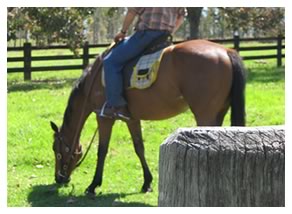
Home › Saddle Fitting Basics
In my experience, even in the best of stables, not enough emphasis is placed on saddle fit. The shape of the horses, the way they engage their hindquarters, and the way they behave often suffer as a result. Too often hours are spent trying to get the horses in the right frame and to train them out of bad behaviour without addressing this root cause. Below is a basic run down of saddle soreness and errors of saddle fitting.
Obvious Saddle Soreness. Horses that are quite sore from the saddle tend to look and act anxious or unhappy when being saddled or may wriggle, bite or kick when the saddle is placed on their back. Girth pain, which is most often because of vertebral and rib problems, can look similar. Saddle sore horses work with a hollow, stiff back and tend to be obviously disengaged behind. “Kissing spines” may result from the dropped or hollow back posture. Like those with girth pain they may pigroot or buck at the start of a ride. Stumbling in front is not uncommon. Other signs include not travelling downhill well and sometimes being cold or hollow backed.
Commonly dry or rubbed spots or white hairs develop over the withers or under the saddle seat. Another possible symptom is not ever walking calmly during rides - always wanting to go faster, acting nicely for the first part of a ride, then deteriorating in behaviour. Horses with badly fitting saddles will have tell-tale soreness in the corresponding areas of the back and will have thickening and scarring of the muscle fibres. Usually this damage is at its worst deep down at the level of the bones of the spine.
Much more common is the situation where horses are only moderately sore from the saddle/rider combination. This situation is so common that it is considered normal, rather than what it is – preventable.
As a consequence of this mild soreness horses drop their back a little under saddle and work a bit stiff and hollow. Mild loss of power from the hind legs usually accompanies this. Hours are spent doing arena work to try to overcome the loss of power and to counter the stiffness, often to no avail because the cause has not been addressed.
Over time horses in this situation lose muscle under the saddle and develop a dropped back. Behaviour and avoidance problems gradually develop, and if ridden enough they start to fall into the obviously sore category.
Where a horse is intensively trained, such as for high level dressage, the saddle fitting has to be near perfect to maximise performance. Subtle fitting problems become a major factor where many hours are spent in the saddle. With repetition even minor back damage will compound into considerable problems over time.
